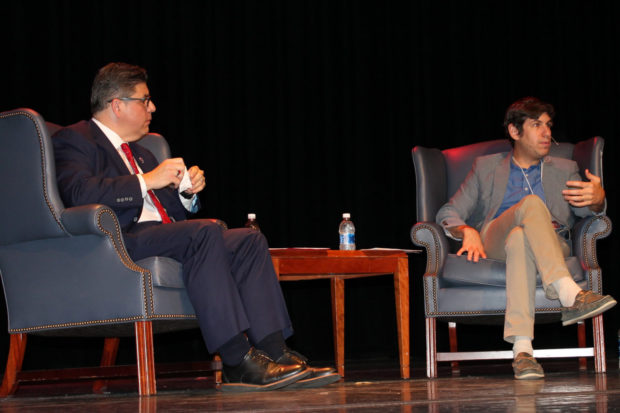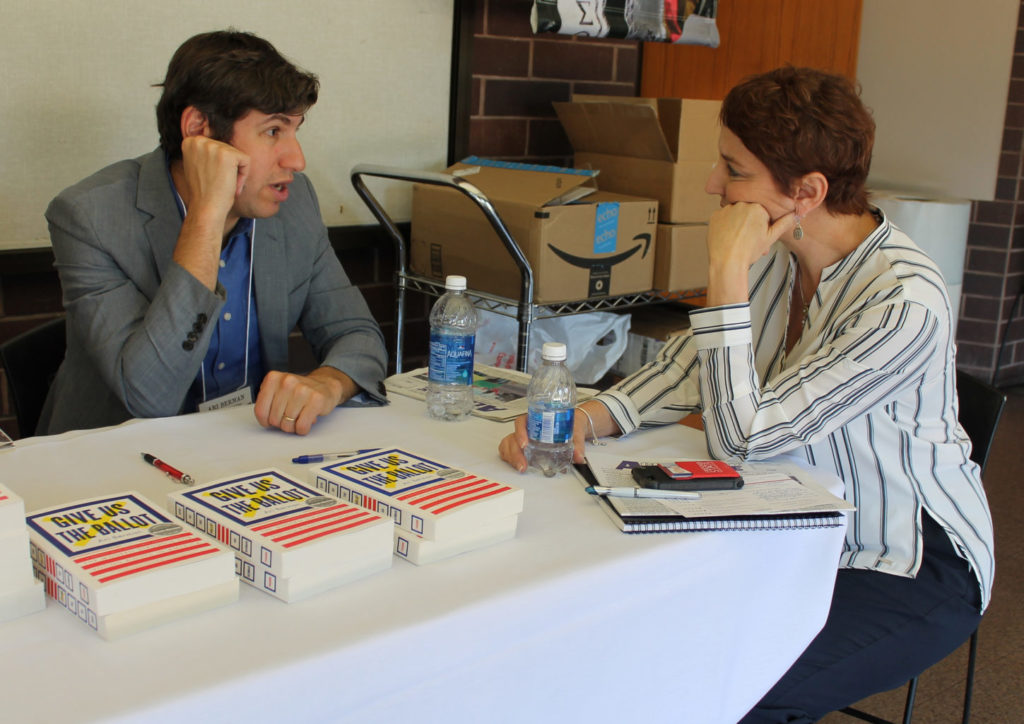
By Hannah Brandt
In the year since the November 2016 presidential election, many have weighed in on the results of that election and their causes. While no doubt a number of factors contributed, one of the most consequential has received little attention–the continued right-wing attack on voting rights, particularly against those of people of color.
One of the few journalists covering this beat at the national level is Ari Berman, a reporter who has spent nearly his entire career at The Nation, until recently leaving for Mother Jones. In May 2017, Berman visited the Central Valley for the first time and led a discussion at Fresno State as part of the university’s Forum on Inclusion, Respect and Equity. Berman spoke at an event titled Truth-Telling: Free Speech and the First Amendment. He focused on his 2015 book, Give Us the Ballot, based on his reporting of the increasing attacks on voting rights, and provided an update on the situation since the 2016 presidential election.
In his book, Berman describes the Civil Rights Act of 1964 and the Voting Rights Act of 1965 as the Second Emancipation so important were they for freedom for people of color, particularly African Americans, who had been shut out of elections primarily in the South through tactics such as literacy tests and poll taxes. Most Americans are aware of this injustice, but many consider it to be confined to the past. It is not.
Civil rights icon John Lewis became frustrated when he gave a speech on the floor of the House of Representatives two months after commemorating the 50th anniversary of the Freedom Rides in 2011. He said, “Voting rights are under attack in America. There is a deliberate and systematic attempt to prevent millions of elderly voters, young voters, students, minority and low-income voters from exercising their constitutional right to engage in the democratic process.” Afterward, he said, “No one seemed to be listening.”
Berman lays out in detail how during the Civil Rights Movement of the 1960s there was a counterrevolution working to prevent and then dismantle the hard-fought civil rights achieved in those years. That counterrevolution had support from GOP leaders such as Ronald Reagan throughout the 1980s and gained momentum in the George W. Bush years but really picked up steam when the Tea Party wing of the GOP took hold of Congress in 2010.
In a dangerous victory, the Supreme Court decision of June 25, 2013, struck down a vital provision in the Voting Rights Act. No longer would states and counties with a history of voter disenfranchisement be prevented from passing new voting laws without federal oversight and approval (known as preclearance). Tactics were modified somewhat from mid-century literacy tests and poll taxes in communities of color to voter ID laws and purging of voter rolls targeting those same communities. But the impact is the same.
Some rural counties in the Central Valley had been subject to preclearance due to a history of voter suppression. Recently, local election monitor Election Protection documented incidents of disenfranchisement in these districts in the 2012 election. The most common is the closure of polling places without notifying people that their polling place has been relocated. In addition, misinformation that IDs are required to vote in California makes confusion common in low-income and immigrant communities. Therefore, these laws in other states have suppressed the vote here, primarily in state and local races.

The effect of overturning the Voting Rights Act has been devastating at the local and national levels, most notably in the election of Donald Trump. Although most mainstream media focus has been on the possible Russian hacking, more evidence of voter suppression by right-wing American forces in districts pivotal for the election have come to light.
In a recent article, “Rigged: How Voter Suppression Threw Wisconsin to Trump (and possibly handed him the whole election),” Berman recounts examples of voter suppression such as a Black woman from Milwaukee named Andrea Anthony. “She lost her driver’s license a few days earlier, but she came prepared with an expired Wisconsin state ID and proof of residency. A poll worker confirmed she was registered to vote at her current address. But this was Wisconsin’s first major election that required voters—even those who were already registered—to present a current driver’s license, passport or state or military ID to cast a ballot. Anthony couldn’t, and so she wasn’t able to vote.
The poll worker gave her a provisional ballot instead. It would be counted only if she went to the Department of Motor Vehicles to get a new ID and then to the city clerk’s office to confirm her vote, all within 72 hours of Election Day. But Anthony couldn’t take time off from her job as an administrative assistant at a housing management company, and she had five kids and two grandkids to look after. For the first time in her life, her vote wasn’t counted.”
Anthony’s 19- and 21-year-old children had misplaced their driver’s licenses and had no other identification that was accepted under Wisconsin’s strict voter ID laws. So they were not able to vote either. According to Berman’s research, African Americans are 50% more likely than Whites to lack the required IDs because they are less likely to drive or have the funds to purchase these documents and they are more likely to have moved from another state. As many as 45,000 people were hindered from voting in Wisconsin due primarily to these voter ID laws. Trump won the state by under 23,000 votes.
In the weeks leading up to the election, the man charged with putting Wisconsin’s voter ID law into practice, U.S. District Judge James Peterson, declared the system a “wretched failure” that “has disenfranchised a number of citizens who are unquestionably qualified to vote.” The judge pointed out that 85% of the people prevented from getting the required IDs from the DMV were Black or Latino. Milwaukee saw the most incidents of disenfranchisement and houses two-thirds of the state’s African American population. Although some voter ID laws have been on the books for several years, 2016 was the first presidential election in which many kicked in. Taking advantage of voter ID laws was a major strategy for Trump and the Republican Party.
Voter suppression in 2016 in Wisconsin reached levels that were cartoonishly appalling. Berman highlights “a man born in a concentration camp in Germany who’d lost his birth certificate in a fire; a woman who’d lost use of her hands but was not permitted to grant her daughter power of attorney to sign the necessary documents at the DMV; a 90-year-old veteran of Iwo Jima who could not vote with his veteran’s ID. One woman who died while waiting for an ID was listed as a ‘customer-initiated cancellation’ by the DMV.”
Wisconsin was not the only state where voter suppression had implications for the results of the 2016 presidential election. Similar tactics in Florida, Ohio, North Carolina and Pennsylvania–states that were also significant in securing Trump’s election–also swayed the outcome. Grassroots voting rights organizations such as Spread the Vote and Let America Vote, as well as the ACLU, have been working hard to protect civil liberties and make sure there are finally political repercussions for those who carry out these attacks. To accomplish this, the American public must recognize and denounce these civil rights violations.
*****
Hannah Brandt is the editor of the Community Alliance newspaper. Follow her on Twitter and Instagram at @HannahBP2. Follow the paper on Facebook at Community Alliance Newspaper and on Twitter and Instagram @fresnoalliance.
